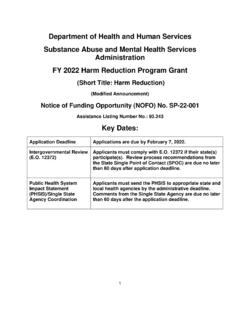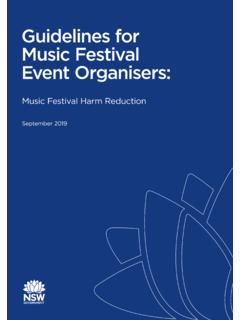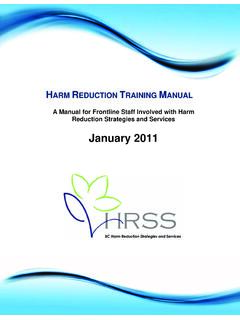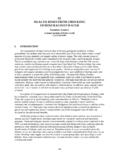Transcription of NCI Flex Risk of Restraints - Crisis Prevention Institue
1 211 Understanding the risks of Physical RestraintsAppendix 2 OverviewThe use of restraint remains contentious particularly due to the specific concerns and risks associated with such practice. As such, this resource is intended to support and promote positive practice and to ensure that physical interventions are used as part of our commitment to Care, Welfare, Safety, and SecuritySM. In accordance with current legislation and guidance, the circumstances that may justify the use of physical interventions include: When an individual poses a significant risk to self.
2 When an individual poses a significant risk to others. When an individual causes damage to property that may result in significant risk of harm to self or any legal and professional justification, physical interventions are not free from risk, and as such professional staff have a duty of care to minimize the psychological and physiological adverse outcomes that are associated with such practice. When using physical interventions to manage the risks associated with an individual s behavior, staff face the dilemma that the specific intervention used may compromise the welfare and safety of those involved.
3 And as such it is important that physical interventions are applied within a context of best practice in order to minimize risks associated With the Use of Physical InterventionsIn circumstances where it has been identified that physical interventions are an appropriate response to manage a prevailing risk associated with an individual s behavior, it is important that staff fully understand the adverse impact physical interventions may have. (See Figure 1.) While there is a need to reduce psychosocial impact and soft-tissue and articular/bony injuries, there is a clear priority that every effort should be made to ensure restraint-related deaths are 1.
4 Restraint-Related Injury or HarmPsychosocial Injury Including post-traumatic stress disorder and damage to therapeutic Injury Including injury to skin, muscles, ligaments, and or Bony Injury Including injury to joints and Restriction Including compromise to airway, bellows mechanism, and gaseous exchange, which results in respiratory Crisis or Compromise Including compromise to the heart and the peripheral vascular the risks of Physical RestraintsTheories of Restraint-Related DeathsThere has been a growing body of opinion that highlights that specific interventions are associated with higher risks to the person being restrained.
5 However, while this view remains dominant among practitioners, organizations, and legislators, the evidence shows that although physical restraint has the ability to impede or restrict life-maintaining physiological functions, the imposed impediment is not uniform between different restraint positions. In particular, the term positional asphyxia (Reay, et al. 1988), which is misunderstood and inconsistently used and interpreted, is often viewed as the mechanism for sudden restraint-related death and has become synonymous with prone restraint a conclusion primarily based on 2011, the Independent Advisory Panel on Deaths in Custody commissioned a review of medical theories, case studies, and research and concluded that certain groups are more vulnerable to the risks of restraint as a result of specific bio-physiological, interpersonal, situational, or attitudinal factors.
6 From this review, it is clear that certain individuals have personal characteristics that may make them more vulnerable to restraint-related adverse outcomes and, in particular, restraint-related death. More recently, Barnett, et al. (2012) published a 30-year review of all the scientific studies related to the physiological impact of restraint and raised attention to the fact that few scientific studies on the physiological impact of restraint have been undertaken with the findings from these not completely valid or generalizable to the real-life event.
7 As a result of the recent published reviews, Figure 2 below illustrates an overview of the evidence from the literature, case studies, and experimental research and demonstrates there are a number of complex issues related to adverse outcomes of restraint suggesting that restraint-related death, in particular, is a multi-factorial 2: Restraint-Related Deaths A Multi-Factorial EventMost Vulnerable IndividualsContributing/Situational Factors People with serious mental illness. People with intellectual disabilities or cognitive impairment.
8 People from minority ethnic groups. People with a high body mass index. Men aged 30 40 years. Children and young people below the age of 20 years. People who are held for prolonged periods of time.** While some researchers, O Halloran, et al. (2000) and Miller (2004), provide case-study evidence to suggest collapse can occur between 2 and 12 minutes, others such as Parkes (2000) argue that Restraints involving prolonged, severe struggle are of greatest People who have a pre-existing health condition that is compromised by physical restraint: Respiratory disease, cardiovascular disease, epilepsy, Stress-related cardiomyopathy.
9 A weakening of the heart muscle triggered by high levels of emotional stress or anxiety resulting in high circulating levels of catecholamines (adrenaline and epinephrine).3. External respiratory restriction as a result of the restraint position: Positional asphyxia associated with prone, hog-tie, and flexed-seated Intoxication: An adverse physiological state produced by a poison or other toxic substance (especially cocaine), which results in erratic or violent Excited delirium: A combination of acute behavioral disturbance, agitation, severe anxiety, disorientation, and elevated body temperature.
10 associated with severe mental illness and/or drug Respiratory acidosis: A decrease in respiratory ventilation resulting in a buildup of carbon dioxide leading to increased acidity in the blood and Thromboembolic disease: A cardiovascular condition involving the obstruction of blood flow to one or more arteries in the Use of prescribed psychotropic medication: Prescribed medication which may have an adverse effect on the person s physiology resulting in hypotension, respiratory compromise, and, in extreme cases, neuroleptic malignant 2213 Understanding the risks of Physical RestraintsPositional Asphyxia and Restraint PositionAlthough there are a relatively small number of restraint-related deaths reported in health, educational, and social care environments occurring during and/or in close proximity to physical restraint (Independent Advisory Panel on Deaths in Custody, 2011)















